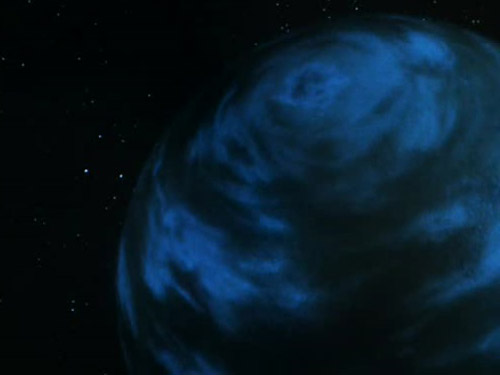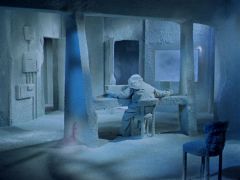Difference between revisions of "Psi 2000 (FASA)"
m |
m |
||
| Line 6: | Line 6: | ||
{{TableRow|title=Advertising|data={{AmazonLinkTOSBD}} }} | {{TableRow|title=Advertising|data={{AmazonLinkTOSBD}} }} | ||
|}</div> | |}</div> | ||
| + | {{BannerFASA}} | ||
Before Psi 2000's sun, an unstable [[G-Type star|yellow subdwarf]],<ref name="Maps"/> "went dark," it was very similar to [[Earth]],<ref name="TOS06"/> though slightly larger, with a diameter of 10,000 [[miles]]. Psi 2000 was given the catalog designation of ULAPG42821DB, which earned it the nickname of "La Pig" from the crew of the [[U.S.S. Enterprise NCC-1701 (FASA)|U.S.S. ''Enterprise'' NCC-1701]]<ref name="TOS06Blish"/> when the ship was sent to retrieve a scientific team from the surface of Psi 2000 and to observe the planet's collapse on [[Stardate]] [[2207 (FASA)#SD1704|1704.2]]. The gravitational forces from the phenomenon, however, caused [[water (FASA)|water]] to become a complex molecule, resulting in [[polywater intoxication (FASA)|polywater intoxication]].<ref name="TOS06"/> The entire six-person<ref name="TOS06Blish"/> scientific team on the surface died, and the polywater intoxication nearly claimed the ''Enterprise'' as well.<ref name="TOS06"/> The last remaining planet in the system, Psi 2000 was reduced to an [[asteroid belt]], and planetary debris began to travel through the system on uncharted trajectories. A danger classification of D-421 was issued for the system, and spacecraft were urged to exercise caution when traveling through it.<ref name="Maps"/> | Before Psi 2000's sun, an unstable [[G-Type star|yellow subdwarf]],<ref name="Maps"/> "went dark," it was very similar to [[Earth]],<ref name="TOS06"/> though slightly larger, with a diameter of 10,000 [[miles]]. Psi 2000 was given the catalog designation of ULAPG42821DB, which earned it the nickname of "La Pig" from the crew of the [[U.S.S. Enterprise NCC-1701 (FASA)|U.S.S. ''Enterprise'' NCC-1701]]<ref name="TOS06Blish"/> when the ship was sent to retrieve a scientific team from the surface of Psi 2000 and to observe the planet's collapse on [[Stardate]] [[2207 (FASA)#SD1704|1704.2]]. The gravitational forces from the phenomenon, however, caused [[water (FASA)|water]] to become a complex molecule, resulting in [[polywater intoxication (FASA)|polywater intoxication]].<ref name="TOS06"/> The entire six-person<ref name="TOS06Blish"/> scientific team on the surface died, and the polywater intoxication nearly claimed the ''Enterprise'' as well.<ref name="TOS06"/> The last remaining planet in the system, Psi 2000 was reduced to an [[asteroid belt]], and planetary debris began to travel through the system on uncharted trajectories. A danger classification of D-421 was issued for the system, and spacecraft were urged to exercise caution when traveling through it.<ref name="Maps"/> | ||
{{Clear|value=left}} | {{Clear|value=left}} | ||
Latest revision as of 06:19, 5 February 2022
| Coordinates | 51.9, -15.1, -34.3[1] |
| Class | M |
| First Appearance | TOS 06 (29 Sep 1966) |
| Advertising |
Before Psi 2000's sun, an unstable yellow subdwarf,[1] "went dark," it was very similar to Earth,[2] though slightly larger, with a diameter of 10,000 miles. Psi 2000 was given the catalog designation of ULAPG42821DB, which earned it the nickname of "La Pig" from the crew of the U.S.S. Enterprise NCC-1701[3] when the ship was sent to retrieve a scientific team from the surface of Psi 2000 and to observe the planet's collapse on Stardate 1704.2. The gravitational forces from the phenomenon, however, caused water to become a complex molecule, resulting in polywater intoxication.[2] The entire six-person[3] scientific team on the surface died, and the polywater intoxication nearly claimed the Enterprise as well.[2] The last remaining planet in the system, Psi 2000 was reduced to an asteroid belt, and planetary debris began to travel through the system on uncharted trajectories. A danger classification of D-421 was issued for the system, and spacecraft were urged to exercise caution when traveling through it.[1]
Image Gallery
Notes and References
- ↑ 1.0 1.1 1.2 Maynard, Jeff (Author). Star Trek Maps. Star Trek. Book. Bantam Books. August 1980.
- ↑ 2.0 2.1 2.2 Roddenberry, Gene (Executive Producer). "The Man Trap". Star Trek, season 1, episode 1 (Production number 06). Directed by Marc Daniels. Written by George Clayton Johnson. Desilu Productions. 8 September 1966.
- ↑ 3.0 3.1 Blish, James (Author). "The Unreal McCoy," Star Trek 1. Star Trek. Novelization . Adapted from "The Man Trap," written by George Clayton Johnson. Ballantine Books. January 1967.



